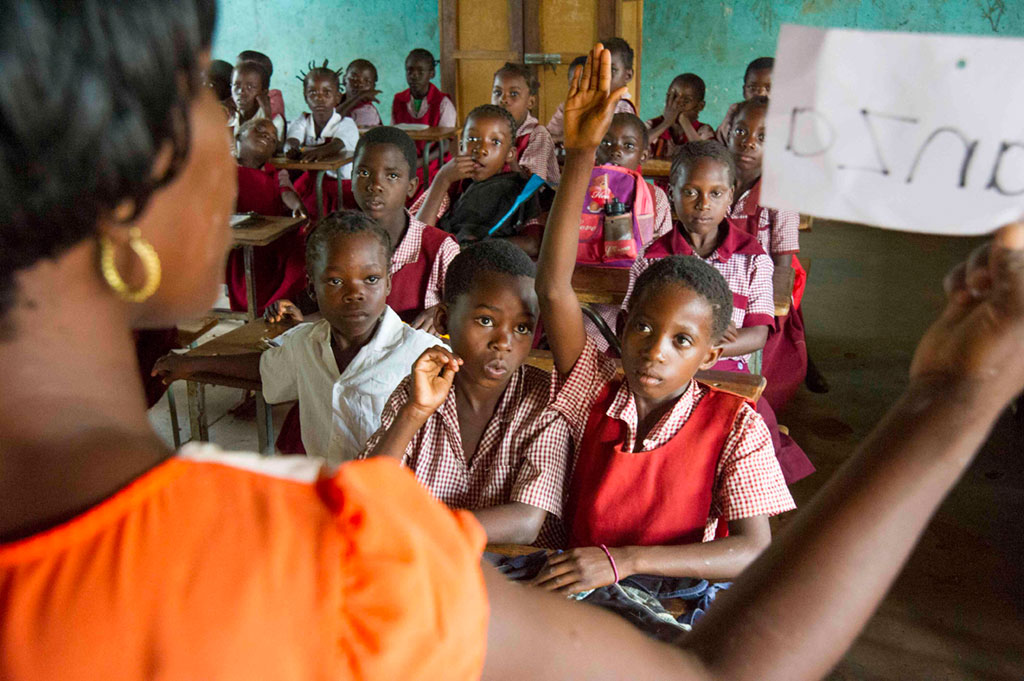Mansa, Zambia—When Head Teacher Muonga Chibwili Dickson stepped into his leadership role at Mabumba Primary School in 2012, he faced a difficult road ahead.
Literacy levels were dismal, affecting student performance across subject areas and contributing to low teacher morale. In 2013, only 39 percent of the school’s second grade students met the standard for grade-level reading and writing.
But 2013 was also the year the school began to implement interventions with support from Read to Succeed—a U.S. Agency for International Development-funded project to build capacity in the Ministry of General Education and improve reading using a phonetic approach among learners in grades 1 to 4 in their local Zambian languages.
Active in more than 1,200 primary schools across six provinces, the USAID Read to Succeed project uses a “whole school, whole teacher, whole learner” approach to improve learning, teaching, school management, parental and community support and responsiveness to a child’s psychosocial needs. Creative Associates International implements the project

In 2015, after nearly three full years of implementation, more than 79 percent of the Mabumba second graders hit the mark for reading and writing. The school’s success is audible as young readers proudly stand in front of their classmates reading from storybooks, and others call out as they read the signs posted all over school as part of the project’s “Talking Walls” strategy.
At the helm of this great achievement, Dickson attributes the jumps in literacy at his school to a couple of key things—the adoption of effective, phonics-based teaching methods by Mabumba Primary School teachers and putting systems in place to keep supporting teachers so that future students will also get the chance to become great readers.
“From 2013 what we have done is to continue the program. We have continued to train our teachers so the program doesn’t die,” says Dickson.
As he speaks, he pulls out file after file, which catalogue the school’s plans for and records of community engagement, teacher professional development, and support to vulnerable learners among other key project components. As a zonal center school, Mabumba Primary School also takes the lead in sharing best practices across the school zone, benefiting countless teachers and students.
“All that we have learned from Read to Succeed we have kept in our files,” he adds.
Click here to see videos and stories from the special report, “Zambia: Turning the page for better schools.”
Sustainability from the ground up to the Ministry
In its nearly five years, the USAID Read to Succeed project has worked in sync with the Ministry of General Education, providing technical assistance while the Ministry has taken the lead. With this support, the Ministry has put in place a new National Literacy Framework, revised curriculum, school-based assessments, a school management framework and performance level descriptors.
“They filled up the gaps that the Ministry could not do,” says Chansa Chibesa, Senior Education Officer for Luapula Province.
“They filled up the gaps that the Ministry could not do.” Chansa Chibesa, Senior Education Officer for Luapula Province
Before the project began, for example, the Ministry of General Education did not have an accurate tool to measure and assess student performance, say officials.
Working within existing Ministry of General Education systems, the USAID Read to Succeed project has helped to strengthen a network of training and education support teams for school heads and literacy teachers from the national level down to the provincial, district, zonal and ultimately school level.
“The system of Read to Succeed is running very much in tandem with the Ministry,” says Simon Kanchebele, acting Provincial Education Standards Officer for Luapula, adding that the project has been instrumental in supporting the Ministry of Education’s literacy policy reform across the board.
In addition to the government’s support systems, head teachers like Dickson have completed Education Leadership and Management Training and serve as in-house supports for literacy teachers.
This layered system of support within the Ministry all the way down to schools means ongoing coaching for educators as they implement the phonics-based methodology for years to come.
“We are not saying this training ends with Read to Succeed. As much as the project has assisted, these trainings should be ongoing at the school level,” says Charles Mupeta, Luapula Provincial Resource Center Coordinator.
Motivated by the fruits of their labor

And Ministry officials say they have good reason to believe that the systems put in place by the project will endure, not just at the top level but on the ground at schools as well.
In a midline survey, released in 2015, Luapula Province second and third graders ranked the highest among the six project provinces in four key areas of reading—letter sound, non-word reading, oral reading passage and English listening comprehension.
In all six provinces, the midline survey showed that the performance of second graders increased by more than three-fold in four out of seven “subtasks” of reading measured. While there is still progress to be made in areas like writing and comprehension, educators and officials note that these are remarkable gains.
“Teachers, parents and administrators are quite happy. Their pride is to see an immediate result from their input. Teachers are leading with their heads high, knowing that their pupils can read,” says Chibesa. “I don’t see them abandoning Read to Succeed. They have seen the fruits of their labor.”
Looking ahead to the close of the project in 2017, education officials are certain that literacy levels will continue to climb and more and more young Zambians will gain literacy skills that will propel them to success in school and beyond.
“Even if Read to Succeed is not there, we are still going with that program to teach reading with the phonetic method. It is part and parcel of us,” says Simon.
With reporting by Nephas Hindamu
